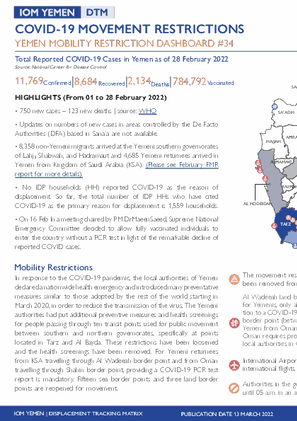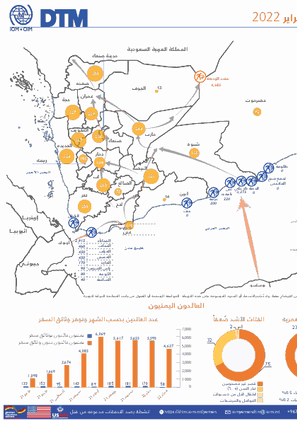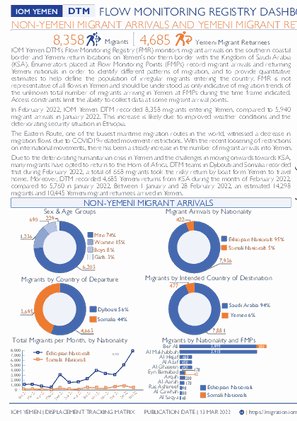-
Countries
-
Data and Analysis
-
Special Focus
-
Crisis Responses

Contact
DTM Yemen, iomyemendtm@iom.int
Language
English
Location
Yemen
Period Covered
Feb 01 2022
Feb 28 2022
Activity
- Points of Entry (PoE)
HIGHLIGHTS (From 01 to 28 February 2022)
• 750 new cases – 123 new deaths | source: WHO
• Updates on numbers of new cases in areas controlled by the De Facto Authorities (DFA) based in Sana’a are not available.
• 8,358 non-Yemeni migrants arrived at the Yemeni southern governorates of Lahjو Shabwah, and Hadramaut and 4,685 Yemeni returnees arrived in Yemen from Kingdom of Saudi Arabia (KSA). (Please see February FMR report for more details).
• No IDP households (HH) reported COVID-19 as the reason of displacement. So far, the total number of IDP HHs who have cited COVID-19 as the primary reason for displacement is 1,559 households.
• On 16 Feb In a meeting chaired by PM DrMaeenSaeed, Supreme National Emergency Committee decided to allow fully vaccinated individuals to enter the country without a PCR test in light of the remarkable decline of reported COVID cases.
Contact
DTM Yemen, iomyemendtm@iom.int
Location
Yemen
Activity
- Flow Monitoring Survey
- Flow Monitoring
Period Covered
Feb 01 2022 -Feb 28 2022
IOM Yemen DTM’s Flow Monitoring Registry (FMR) monitors migrant arrivals on the southern coastal border and Yemeni return locations on Yemen's northern border with the Kingdom of Saudi Arabia (KSA). Enumerators placed at Flow Monitoring Points (FMPs) record migrant arrivals and returning Yemeni nationals in order to identify different patterns of migration, and to provide quantitative estimates to help define the population of irregular migrants entering the country. FMR is not representative of all flows in Yemen and should be understood as only indicative of migration trends of the unknown total number of migrants arriving in Yemen at FMPs during the time frame indicated. Access constraints limit the ability to collect data at some migrant arrival points.
In February 2022, IOM Yemen DTM recorded 8,358 migrants entering Yemen, compared to 5,940 migrant arrivals in January 2022. This increase is likely due to improved weather conditions and the deteriorating security situation in Ethiopia.
The Eastern Route, one of the busiest maritime migration routes in the world, witnessed a decrease in migration flows due to COVID19-related movement restrictions. With the recent loosening of restrictions on international movements, there has been a steady increase in the number of migrant arrivals into Yemen.
Due to the deteriorating humanitarian crisis in Yemen and the challenges in moving onwards towards KSA, many migrants have opted to return to the Horn of Africa. DTM teams in Djibouti and Somalia recorded that during February 2022, a total of 668 migrants took the risky return by boat form Yemen to travel home. Moreover, DTM recorded 4,685 Yemeni returns from KSA during the month of February 2022, compared to 5,760 in January 2022. Between 1 January and 28 February 2022, an estimated 14,298 migrants and 10,445 Yemeni migrant returnees arrived in Yemen.
Population Groups
Survey Methodology
Unit of Analysis Or Observation
Type of Survey or Assessment
Keywords
Geographical Scope
Administrative boundaries with available data
The current dataset covers the following administrative boundaries

Contact
DTM Yemen, iomyemendtm@iom.int
Language
Arabic
Location
Yemen
Period Covered
Feb 01 2022
Feb 28 2022
Activity
- Flow Monitoring Survey
- Flow Monitoring
- Mobility Tracking
تعمل مصفوفة تتبُع النزوح الخاصة بالمنظمة الدولية للهجرة في اليمن على مراقبة المواقع الرئيسية التي يصل عبرها المهاجرون على الحدود الساحلية الجنوبية، و مواقع العائدون اليمنيون والموجودة على الحدود الشمالية لليمن مع المملكة العربية السعودية. يُراقب الباحثون المتمركزون في نقاط رصد تدفق وصول المهاجرين والمواطنين اليمنيين من أجل التعرف على الأنماط المختلفة للهجرة وتقديم تقديرات كمية للمساعدة في تحديد عدد المهاجرين غير النظاميين في البلد. لا تمثل نقاط التدفق جميع التدفقات في اليمن ويجب فهمها على انها مؤشر فقط لاتجاهات الهجرة للعدد الاجمالي الغير معروف للمهاجرين الذين يصلون الى اليمن في نقاط مراقبة التدفق في فترة التقرير. والجدير بالذكر أن القيود المفروضة على الوصول تَحُد من القدرة على جمع البيانات في بعض نقاط وصول المهاجرين.
في فبراير 2022 ، سجلت مصفوفة تتبع النزوح التابعة للمنظمة الدولية للهجرة في اليمن 8,358 مهاجرًا دخلوا اليمن ، مقارنة بـ 5,940 مهاجرًا في يناير 2022. تعود الزيادة في عدد المهاجرين في فبراير 2022 مقارنةً بشهر يناير 2022 إلى تحسن الأحوال الجوية وتدهور الوضع الأمني في إثيوبيا.
شهد الطريق الشرقي ، أحد أكثر طرق الهجرة البحرية ازدحامًا في العالم ، انخفاضًا في تدفقات الهجرة بسبب قيود الحركة المرتبطة بكورونا COVID19مع تخفيف القيود مؤخرًا على التحركات الدولية ، كانت هناك زيادة مطردة في عدد المهاجرين الوافدين إلى اليمن. بسبب الأزمة الإنسانية المتدهورة في اليمن والتحديات في المضي قدمًا نحو المملكة العربية السعودية ، اختار العديد من المهاجرين العودة إلى القرن الأفريقي. سجلت فرق مصفوفة تتبع النزوح في جيبوتي والصومال خلال فبراير 2022 ، تسجيل 668 مهاجرا عائداً بالقارب من اليمن. بالإضافة إلى ذلك ، سجلت مصفوفة تتبع النزوح حوالي 4،685 يمني عادوا من المملكة العربية السعودية خلال شهر فبراير 2022، مقارنة بـ5,760 في يناير 2022. خلال الفترة بين 1 يناير و 28 فبراير 2022، وصل ما يقدر بـ 14،298 مهاجرًا و 10,445 يمنيًا عائداً إلى اليمن.
حيث مثل عدد المهاجرين من إثيوبيا 95 في المائة و 5 في المائة من الصوماليين. كانت غالبية المهاجرين من الذكور (74 ٪) ، مع (15) من النساء ، و ثمانيه في المائة من الأولاد وثلاثة في المائة من الفتيات اللواتي كنا ايضاً من ضمن المسافرين.
خلال فترة التقرير في فبراير 2022، شوهد وصول 3,695 مهاجرا من الصومال وتم تسجيلهم في نقاط مراقبة التدفق في محافظة شبوة حيث سجل في بئر علي الرقم الاكبر 3,275 مهاجرا وا 220 في عين بامعبد؛ و 200 تم تسجيلهم في نقطة مراقبة التدفق بعرقة .بينما شهدت نقاط مراقبة التدفق بمديرية المضاربة والعارة بمحافظة لحج وصول الرقم الاكبر بتسجيل 4,663 مهاجرا وصلوا من جيبوتي , حيث تم تسجيل 2,915 في المخاباه ؛ وا 460 في الحجاف ؛وا 450 في العزاف ؛وا 450 في الغصين ؛ وا 170 في العاره ؛ وا 98 في راس الشريف؛ وا 80 في الكوحه ؛ وا 40 في الساقية.
المنهجيــة:
تهدف منهجية تتبع النزوح العالمية إلى التعرف على المناطق التي تحدث فيها الهجرة الداخلية والهجرة العابرة للحدود والهجرة الإقليمية. وتُنَفَذّ تقييمات التنقل للمناطق على المستوى الوطني. ومن ثم تقوم فرق مصفوفة التتبع بجمع المعلومات على المستوى المحلي للتعرف على نقاط العبور الرئيسية. يجمع الباحثون الميدانيون البيانات من مُدلين رئيسين بالمعلومات في نقاط رصد التدفق: ويمكن للمُدلين الرئيسيين ان يكونوا افرادً يعملون في النقل او موظفون في الجمارك او افرادً يعملون في قوارب او المهاجرون انفسهم. تُجمع البيانات باستخدام استمارة بسيطة و بالملاحظة المباشرة وهو ما يُسَهل عملية التحليل.
القيــــــود:
يجب تفسير البيانات المستخدمة في هذه العمليات كتقديراتً فقط، وانها تمثل فقط جزءاً من اجمالي التدفق الذي يمر عبر اليمن. ولذلك، ان التغطية الزمنية والمساحية غير مكتملة. وبالإضافة إلى ذلك، بالرغم من ان البيانات تُجمع بشكل يومي، إلا انها تُجمع فقط خلال ساعات الذروة. وإن نسبة التدفقات التي تحدث في الساعات التي لم تتم تغطيتها، لا تُمَثَل هنا. أما البيانات المتعلقة بالضُعف فهي ترتكز على الملاحظة المباشرة ويجب ان تفُهم بصفتها بيانات دلالية في المقام الأول.

Contact
DTM Yemen, iomyemendtm@iom.int
Language
English
Location
Yemen
Period Covered
Feb 01 2022
Feb 28 2022
Activity
- Flow Monitoring Survey
- Flow Monitoring
- Mobility Tracking
IOM Yemen DTM’s Flow Monitoring Registry (FMR) monitors migrant arrivals on the southern coastal border and Yemeni return locations on Yemen's northern border with the Kingdom of Saudi Arabia (KSA). Enumerators placed at Flow Monitoring Points (FMPs) record migrant arrivals and returning Yemeni nationals in order to identify different patterns of migration, and to provide quantitative estimates to help define the population of irregular migrants entering the country. FMR is not representative of all flows in Yemen and should be understood as only indicative of migration trends of the unknown total number of migrants arriving in Yemen at FMPs during the time frame indicated. Access constraints limit the ability to collect data at some migrant arrival points.
In February 2022, IOM Yemen DTM recorded 8,358 migrants entering Yemen, compared to 5,940 migrant arrivals in January 2022. This increase is likely due to improved weather conditions and the deteriorating security situation in Ethiopia.
The Eastern Route, one of the busiest maritime migration routes in the world, witnessed a decrease in migration flows due to COVID19-related movement restrictions. With the recent loosening of restrictions on international movements, there has been a steady increase in the number of migrant arrivals into Yemen.
Due to the deteriorating humanitarian crisis in Yemen and the challenges in moving onwards towards KSA, many migrants have opted to return to the Horn of Africa. DTM teams in Djibouti and Somalia recorded that during February 2022, a total of 668 migrants took the risky return by boat form Yemen to travel home. Moreover, DTM recorded 4,685 Yemeni returns from KSA during the month of February 2022, compared to 5,760 in January 2022. Between 1 January and 28 February 2022, an estimated 14,298 migrants and 10,445 Yemeni migrant returnees arrived in Yemen.
The migrant caseload was 95 per cent Ethiopian, and five per cent Somali. The migrants are predominantly male (74%), with (15%) women, eight per cent boys and three per cent girls also among the travelers.
Through February reporting period, 3,695 migrants arrived from Somalia and were recorded 3,275 at Ber Ali, 220 at Eyn Bamabad, and 200 at Arqah flow monitoring points in Shabwah governorate. In Lahj governorate saw the highest number of migrant arrivals, with 4,663 migrants arriving from Djibouti were recorded 2,915 at Al Makhabah, 460 at Al Hejaf, 450 at Al Azaf, 450 at Al Ghaseen, 170 at Al Aarah, 98 at Ras Ashareef, 80 at Al Cawhah, and 40 at Al Saqya flow monitoring points.
METHODOLOGY:
DTM’s global flow monitoring methodology aims to identify areas prone to internal, cross-border and regional migration. Mobility area assessments are conducted at the national level. DTM teams then collect information at the local level to identify key transit points. Enumerators collect data from key informants at the flow monitoring points: key informants may be transport staff, custom officers, boat operators or migrants themselves. Data is collected through a basic form combined with direct observations –enabling breakdowns.
LIMITATIONS:
Data collected for these exercises should be understood as estimations only. They represent only part of the total flows passing through Yemen. The spatial and temporal coverage of this data collection activity is therefore incomplete. In addition, although data is collected daily, it is collected only during peak hours. The portion of the flows that occur during the uncovered hours is not represented. Data on vulnerability is based on direct observation and should be understood as mainly indicative.

Contact
DTMColombia@iom.int
Language
Spanish
Location
Colombia
Period Covered
Jul 01 2021
Dec 31 2021
Activity
- Flow Monitoring
- Mobility Tracking
Con el fin de monitorear los movimientos e identificar las necesidades de refugiados y migrantes venezolanos como insumo para diseñar una mejor respuesta, la Organización Internacional para las Migraciones (OIM) y el Grupo Interagencial sobre Flujos Migratorios Mixtos (GIFMM), han desarrollado desde julio de 2021 un ejercicio de monitoreo a través de analítica de WiFi , contando con 42 puntos localizados en diferentes departamentos, incluyendo aquellos ubicados en la frontera de Colombia con Venezuela (hacia el nororiente del país) y con Ecuador (suroccidente del país). El proyecto ha permitido beneficiar de manera directa a refugiados y migrantes que han accedido al servicio de internet, mientras que, paralelamente, se ha recolectado información que caracteriza el flujo y los perfiles de población en cada una de las regiones.
Este reporte analiza los resultados correspondientes al período comprendido entre el 18 de junio y el 31 de diciembre de 2021. Las cifras se presentan de forma desagregada para seis regiones delimitadas de acuerdo con las dinámicas históricas del flujo migratorio: región Central, región Caribe, región Caribe Norte, región Oriental, región Nororiental y región Sur, sobre las que se describen los principales hallazgos en términos de movimientos,

Contact
DTM Mozambique, DTMMozambique@iom.int
Language
English
Location
Mozambique
Period Covered
Mar 11 2022
Mar 12 2022
Activity
- Other
Cyclone Gombe made landfall as a Category 3 Tropical Cyclone on Friday, March 11 on the coast between Mossuril and Mogincual districts (Nampula Province). The most hit provinces are Nampula (Angoche, Moma, Mogovolas, Mucuburi, Monapo, Ilha, Lalaua, Mossuril, Nacala Porto and Meconta) and Zambezia (Namacurra, Gile, Nicoadala, Maganja, Pebane, Molocue, Mocubela, Mopeia, Mocuba and lle), leaving many houses and power lines destroyed with an estimated affected population of 115,336 individuals. Preliminary reports confirm the activation of 6 Accommodation Centres in Nampula.

Contact
DTMMozambique@iom.int
Language
English
Location
Mozambique
Period Covered
Mar 02 2022
Mar 08 2022
Activity
- Event Tracking
- Mobility Tracking
During the reporting period (2 to 8 March 2022), a total of 70 movements were recorded - 57 Arrivals (2,286 individuals), 2 transit (150 individuals) and 11 departures (584 individuals). The largest arrival movements were recorded in Nangade (1126 individuals), Mueda (300 individuals), Pemba (290 individuals), and Chiure (162 individuals). The largest departures were observed in Nampula (318 individuals), and Nangade (91 individuals). Of the total population, 46 per cent of the mobile groups were displaced for the first time, and 54 per cent of reported to having been displaced more than once prior to this movement.

Contact
Angelica Madrigal amadrigal@iom.int / Miranda Mora mmora@iom.int
Language
English
Location
Costa Rica
Period Covered
Feb 01 2022
Feb 28 2022
Activity
- Flow Monitoring
In the context of the COVID-19 emergency, since March 19, 2020, the Government of Costa Rica has kept its land border with Panama closed for the Binational Controlled Flow Operation, which sought an orderly and safe migration of migrants moving through the Americas3.
Given the presence of this irregular migration flow, since August 24, 2021, IOM Panama has published information on the irregular migration flow in Darién, Panama4 under the context of COVID-19, identifying that between August 2021 and January 2022, 93,139 migrants have entered Panama: Haiti (61%), Cuba (11%), Chile and Brazil with 7 percent, Bolivarian Republic of Venezuela (4%), among other countries of South America, Africa and Asia (10%).
In Costa Rica, during 2022, a steady increase in the number of migrants of this migration flow has been identified (it has increased by 20% compared to December 2021, when the monitoring of flows in Costa Rica began). In addition, according to data from the General Directorate of Migration and Foreigners (DGME), during May 2021 and February 2022, 4,976 rejections5 have been made in Paso Canoas.
In Costa Rica, there are many perceived vulnerabilities: people traveling alone, children, disoriented elderly people, people with medical problems, emotional exhaustion caused by stress, anguish and frustration. In addition, the main needs identified are associated with access to food, clothing, diapers, shelter, medicines and transportation. Many people have lost their identification documents and are reluctant to receive medical assistance, as they believe that they would not be allowed to continue their journey.

Contact
Angelica Madrigal amadrigal@iom.int / Miranda Mora mmora@iom.int
Language
Spanish
Location
Costa Rica
Period Covered
Feb 01 2022
Feb 28 2022
Activity
- Flow Monitoring
En el marco de la emergencia por la COVID-19, desde el 19 de marzo del 2020, el Gobierno de Costa Rica mantiene cerrada su frontera terrestre con Panamá para la Operación Binacional Flujo Controlado, la cual procuraba una migración ordenada y segura de personas migrantes en situación de movilidad por América3.
Ante la presencia de este flujo migratorio irregular, desde el 24 de agosto de 2021, OIM Panamá ha publicado información sobre el flujo migratorio irregular en Darién, Panamá4 bajo el contexto de la COVID-19, identificando que, desde agosto de 2021 y enero de 2022, han ingresado a Panamá 93.139 personas migrantes: Haití (61%), Cuba (11%), Chile y Brasil con 7%, República Bolivariana de Venezuela (4%), entre otros países del Sur de América, África y Asia (10%).
En Costa Rica, durante el 2022, se ha identificado un aumento constante en la cantidad de personas migrantes de este flujo migratorio (ha aumentado en un 20% en comparación con diciembre, 2021, cuando inició el monitoreo de flujos en Costa Rica). Además, de acuerdo con datos de la Dirección General de Migración y Extranjería (DGME), durante mayo de 2021 y febrero de 2022 se han realizaron 4.976 rechazos5 en Paso Canoas.
En Costa Rica se perciben muchas vulnerabilidades: personas viajando solas, niños y niñas, personas adultas mayores desorientadas, personas con problemas médicos, desgaste emocional ocasionado por estrés, angustia y frustración. Además, las principales necesidades detectadas se asocian con el acceso a alimento, ropa, pañales, alojamiento, medicamentos y transporte. Muchas personas han perdido sus documentos de identificación y se reúsan a recibir asistencia médica, pues consideran que no se les permitiría continuar con su viaje.

Contact
jali@iom.int
Language
English
Location
Trinidad & Tobago
Period Covered
Dec 01 2021
Dec 31 2021
Activity
- Survey
- Flow Monitoring Survey
Trinidad and Tobago, similar to many other countries, continues to wrestle with the worst impacts of the COVID-19 pandemic, which became manifest on the island in March 2020. This virus, however, presented another layer of complexity to an already complicated context. More pointedly, since 2016, the country has been grappling with escalating inflows of Venezuelan migrants, given the deteriorating situation in Venezuela. Additionally, from as early as 2014, it encountered significant economic challenges that were precipitated by plummeting energy commodity prices and sector contraction. Consequently, heightened health and safety protocols to combat the spread of the virus, such as the closure of national borders and non-essential businesses; the introduction of virtual school and work; and the declaration of a State of Emergency in May 2021; inadvertently exacerbated economic issues and migrant vulnerabilities.
IOM’s DTM is a system to track and monitor displacement and population mobility. It is designed to capture, process and disseminate critical multi-layered information on the mobility, vulnerabilities, and needs of displaced and mobile populations, regularly and systematically. Hence, the DTM provides decision-makers and responders with insightful data to guide specific assistance to target populations.
A total of 1,376 Venezuelan migrants participated in DTM 2021, between October and November 2021. The areas with the highest number of respondents were Penal/Debe followed by Chaguanas and Tunapuna/Piarco, as shown in Map 1. Notwithstanding this, three respondents indicated that they did not know in which Regional Corporation or district they resided. This may be due to a high level of internal mobility, amongst the Venezuelan migrant population, and resultant frequent changes in residence.